So, you’ve settled on southern Africa as your ideal safari destination, but you can’t choose between two lands of contrasting beauty: Namibia and Botswana. In Namibia, the vast Namib Desert swallows up the land, stretching from sea to city. Further north, wildlife congregates at Etosha National Park to take advantage of its clay pans. Botswana, meanwhile, boasts the Okavango Delta, a UNESCO World Heritage Site frequented by the world’s best wildlife filmmakers and countless travellers.
Despite sharing an immense border, Namibia and Botswana are incredibly different. While Botswana has its own desert regions, including the incredible Central Kalahari Game Reserve, it’s nowhere near as arid as Namibia. Instead, seasonal floods transform the Okavango Delta into a veritable wetland paradise – during the dry season, no less!
However, when it comes to safaris, both countries boast some of the finest game viewing in all of Africa. So, if you don’t plan on visiting both, how can you possibly choose? Well, we’ve built thousands of bespoke itineraries for travellers over the years, and this is where it all starts. If you really have to choose just one, you’ll need to be equipped with everything you need to know about safaris in Namibia and Botswana, how they differ, and the types of experiences you can expect on either side of the border. Let’s dive straight into it and help you choose your next African safari destination.
Quick Comparison: Namibia vs Botswana
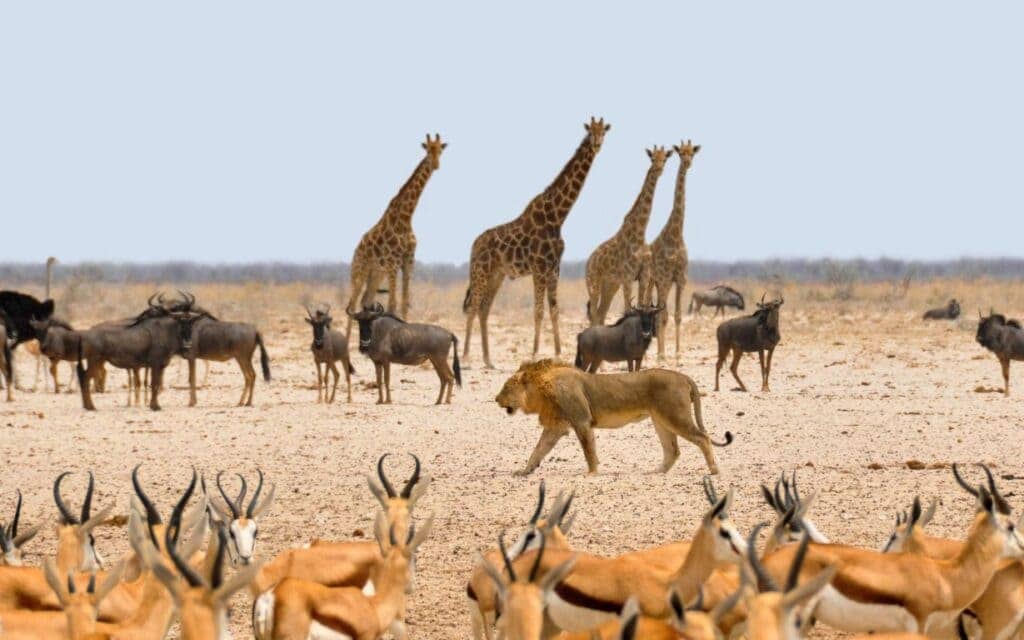
Quick Comparison: Namibia vs Botswana
| Namibia | Botswana | |
| Top Safari Destinations | Etosha National Park, Namib-Naukluft National Park, Erindi Private Game Reserve, Caprivi Strip, Skeleton Coast National Park | Okavango Delta (Moremi Game Reserve), Chobe National Park, Central Kalahari Game Reserve, Makgadikgadi Pans National Park |
| Peak Seasons | July-November | April-July |
| Activity Highlights | Big Five Safaris, Stargazing, Desert Driving, Walking Safaris, Cheetah Tracking, Dune Climbing, Sandboarding, Quad Biking | Big Five Safaris, Chobe River Boat Cruises, Okavango Delta Air Safaris, Mokoro (Canoe) Safaris, Walking Safaris |
| Iconic Wildlife | The Big Five, Gemsbok (Oryx), Springbok, Bat-Eared Foxes, Namaqua Chameleon, Cheetah, Hippopotamus, Giraffe, African Wild Dog, Whale Shark, Damaraland Mole-Rat, Spotted Hyena, Mountain Zebra, Meerkat, Cape Fur Seal | The Big Five, Cheetah, Hippopotamus, Giraffe, African Wild Dog, Spotted Hyena, Zebra, Nile Crocodile |
Climate
| Namibia | Botswana | |
| Rainy Season | September-November; February-April | October-April |
| Dry Season | December-January; May-August | May-September |
| Best Time for Game Viewing | Dry season | Dry season |
The weather is predictable in both countries, especially when planning around the rainy season – and this matters for a safari. During the dry winter months, there’s less vegetation, making it easier to spot wildlife in the bush. Additionally, animals congregate around water sources, ensuring excellent game-viewing opportunities at waterholes and rivers.
Nowhere is this more spectacular than in Botswana’s Okavango Delta. During the dry season, rain is scarce, but the delta transforms into a vast wetland as water flows in from sources far north in Angola. Herbivores thrive on the abundant vegetation, while predators take full advantage. Remarkably, lions in the delta have adapted to navigate crocodile- and hippo-infested waterways to hunt their prey.
In Namibia, the Etosha National Park offers incredible wildlife viewing during the dry season, as animals flock to its famous salt pans and waterholes. Namibia’s desert landscapes, including the iconic Sossusvlei dunes and Skeleton Coast, provide a stark but stunning contrast to its wildlife regions. The country experiences dry winters and hot summers, with minimal rainfall in most areas, making it easier to plan safaris year-round. However, temperatures can soar in the summer months, especially in desert regions, so timing your visit during the cooler winter or shoulder seasons is ideal for comfortable exploration.
If you’re considering pairing a Namibian safari with visits to its unique landscapes, the dry winter months from May to September are the best time to go, ensuring both excellent wildlife viewing and comfortable travel conditions.
Wildlife
| Namibia | Botswana | |
| Unique Wildlife | Mountain zebra, Damaraland mole-rat, Namaqua chameleon, Cape fur seal, gemsbok (oryx) | Chobe black rhinoceros, sitatunga, puku, lechwe |
| Other notable wildlife | Cheetah, zebra, blue wildebeest, spotted hyena, African wild dog, hippopotamus, Nile crocodile, giraffe | Cheetah, zebra, blue wildebeest, spotted hyena, African wild dog, hippopotamus, Nile crocodile, giraffe |
| Notable Birds | African fish eagle, martial eagle, secretarybird, rosy-faced lovebird, Rüppell's parrot, gabar goshawk, Ovambo sparrowhawk, great white pelican, greater flamingo, lesser flamingo | Wattled crane, bearded vulture, Rüppell's parrot, Pel’s fishing owl, grey-crowned crane, Caspian plover, Ovambo sparrowhawk, African fish eagle, martial eagle, secretarybird |
Namibia’s wildlife is as diverse as its dramatic landscapes, offering a unique safari experience. Etosha National Park is a standout destination, renowned for its vast salt pans and waterholes that attract an array of animals, including elephants, lions, rhinos, and giraffes.
Namibia is also home to some of the world’s most iconic desert-adapted species, such as the hardy oryx, springbok, and the unique desert lions and elephants, which have evolved to survive in the harsh arid conditions of the Namib Desert and Kunene Region.
Along the remote Skeleton Coast, visitors may encounter Cape Fur seals and even elusive brown hyenas. Namibia’s commitment to conservation has fostered thriving populations of wildlife, with extensive community-based conservancies playing a key role in protecting species like the critically endangered black rhino.
Botswana’s Okavango Delta presents a more remote and exclusive experience. Known for its seasonal flooding, the delta transforms into a lush oasis during the dry season, attracting large herds of elephants, buffalo, and various predators. Botswana’s Chobe National Park is another prime location for viewing wildlife, particularly its massive elephant populations that criss-cross their way across the Chobe River. The water also attracts huge flocks of migrating birds.
Botswana’s unique water-based safaris and low-impact tourism policies emphasise preservation and seclusion, creating a more intimate connection with nature.
Best Safari Destinations
| Namibia | Botswana | |
| Bush Safaris | Etosha National Park, Erindi Private Game Reserve, Caprivi Strip | Moremi Game Reserve, Chobe National Park, Northern Tuli Game Reserve |
| Desert Safaris | Ai/Ais-Richtersveld Transfrontier Park, Namib-Naukluft National Park | Central Kalahari Game Reserve, Makgadikgadi Pans National Park |
| Marine Safaris | Skeleton Coast National Park |
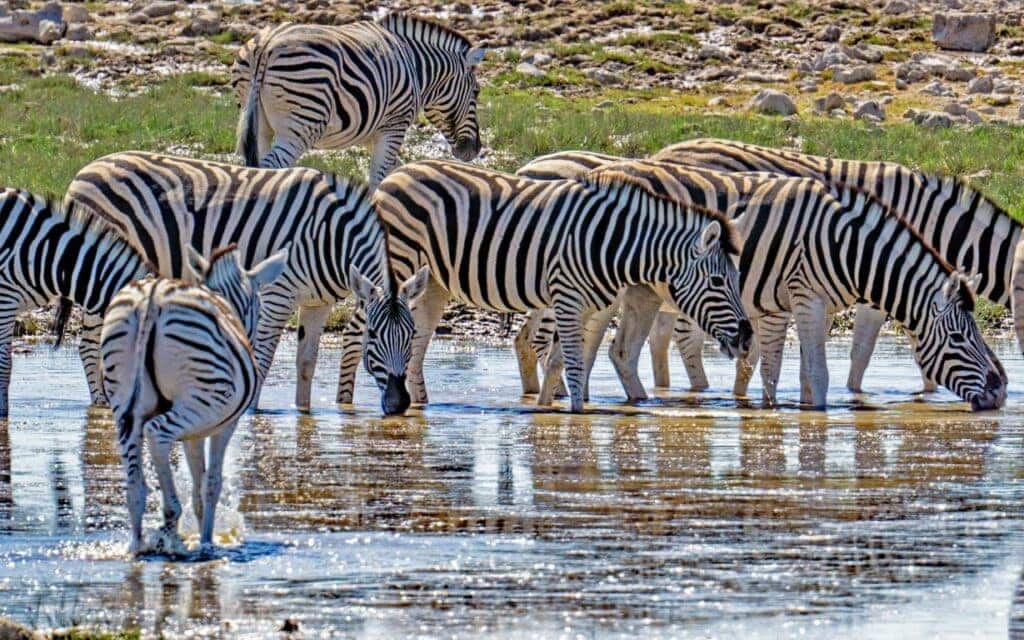
If You Want to See the Big Five
You can see all of the Big Five in Namibia, but unfortunately, you won’t be able to do this in one place. Etosha National Park has four of these iconic animals, but you’ll have to find African buffalo elsewhere.
That makes Botswana the clear winner for Big Five safaris. Both Moremi Game Reserve and Chobe National Park offer epic wildlife sightings, including lions with dark manes and buffalo that spend much of their time with just their heads poking out from the water!
If You Want to See Lots of Elephants
Some sources estimate that there are over 50,000 in Botswana’s Chobe National Park alone. The healthy population means that this is one of the only places where lions actively hunt elephants!
If You Want to See Big Cats
You can see lions, leopards, and cheetahs in both Namibia and Botswana. Namibia is famous for its desert-adapted lions, while Botswana’s Okavango Delta has thriving populations of both lions and leopards.
Namibia also has one of the largest populations of cheetahs that live outside of protected areas, thanks to various conservation initiatives based around the country.
If You Want to See Birds
The Okavango Delta is the undisputed winner here. The seasonal floods attract immense numbers of birds from as far afield as Siberia, and the abundance of local species like eagles, vultures, and colourful bee-eaters makes it a bird photographer’s dream. A bit further south, flamingos and other waders fill the brackish waters of the Makgadikgadi Pans.
Activities
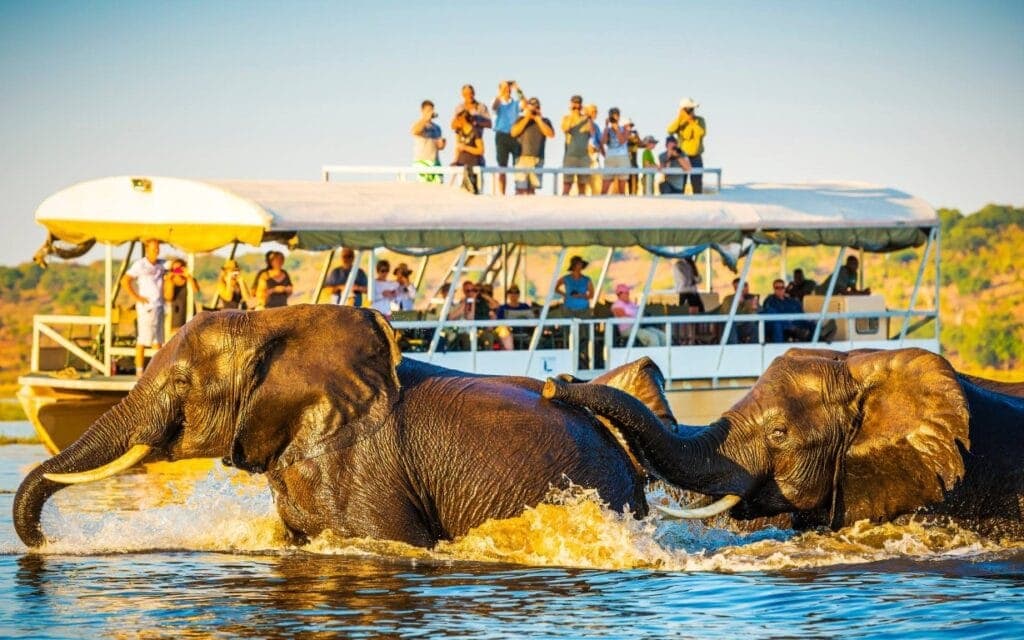
Going on safari is all about wildlife, but you can combine your game viewing with plenty of other exciting activities. In some cases, you can even enjoy a safari from above.
Activities
| Namibia | Botswana | Both Regions | |
| Safari Activities | Desert safaris in Namib-Naukluft National Park | Air safari over the Okavango Delta | Big Five safaris, photographic safaris, walking safaris, birding, horseback safaris, mobile camping |
| Fun Activities | Beach holidays, multi-day hikes, dune quad biking, sandboarding, dune driving, hot air balloon rides, dune climbing, visit to Epupa Falls | Chobe River boat cruise, mokoro (dugout canoe) safaris in Moremi Game Reserve, Victoria Falls day trip | Bush walks, hiking, fishing, stargazing, mountain biking |
| Cultural Activities | Cultural tours, village visits, food tours, positive impact safaris, bush walks with San and Nama guides |
What are the Pros and Cons of Each Region?
| Pros | Cons | |
| Namibia | Excellent game reserve infrastructure, especially in national parks and private game reserves. A blend of bush safaris and desert safaris. Great for self-drive safaris. Coastline makes marine safaris possible. Easy transfers from major cities. | The best wildlife viewing is seasonal. The desert can be hot and harsh, especially in summer. Wildlife is sparse in desert regions. |
| Botswana | Diverse landscapes from deserts to deltas. Excellent infrastructure and a wide range of accommodation options. High concentration of wildlife with fewer tourists in some parks. Wildlife is drawn to water sources in places like Etosha National Park | Some areas can be expensive. The best wildlife viewing is seasonal. Bookings must be made well in advance as spaces are often limited. |
Safety
- Southern Africa is generally safe for tourists, particularly in well-established safari destinations like South Africa, Botswana, and Namibia. However, it is always advisable to follow local guidelines and travel advisories.
- Safari lodges and parks have stringent safety protocols in place to ensure the safety of guests, including guided game drives and secure accommodations.
- Urban areas may have higher crime rates, so travellers should take standard precautions and stay vigilant.
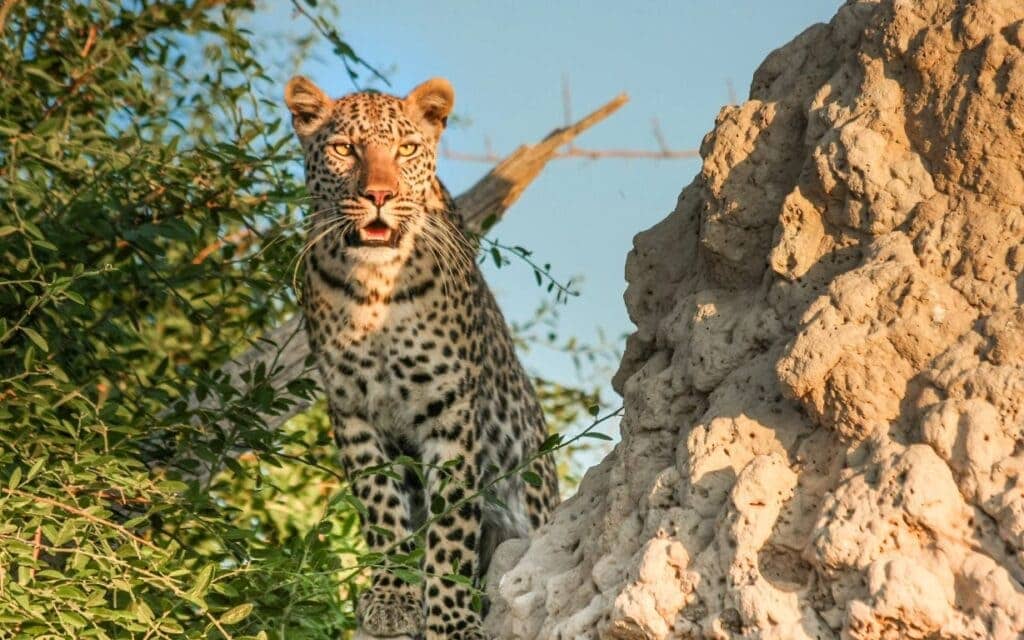
Cuisine
| Namibia | Botswana |
| Aside from more modern dishes, Namibia offers two culinary experiences: one drawing on indigenous cultures like Himba, San, and Herero, and another heavily influenced by the country’s German, Afrikaner, and British colonial histories. Oshikundu is a traditional alcoholic beverage made from fermented millet. Many communities enjoy vetkoek, a fried bread that’s also popular in South Africa. Typical German cuisine includes the Wiener schnitzel and various types of sausages. Safari lodges typically provide a range of gourmet meals, often incorporating local flavours and ingredients. | Botswana’s national dish is seswaa, a type of meat dish made by boiling less desirable cuts of beef or goat in large pots, draining it, and then pounding it into a kind of mincemeat. It’s typically served with pap (maize porridge) or samp (pounded corn kernels). Botswana has its own version of biltong called segwapa. Some indigenous San people still depend on hunting and gathering, drawing on natural resources like ostrich eggs, caterpillars, nuts, tsamma melons, num num (wild plums), and Kalahari truffles. Safari lodges typically provide a range of gourmet meals, often incorporating local flavours and ingredients. |
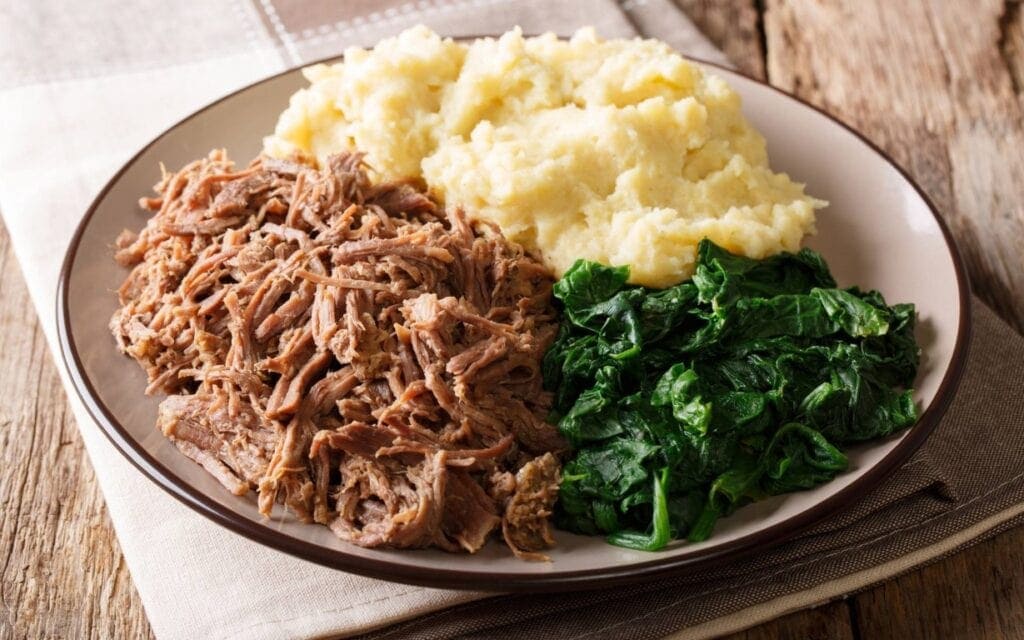
Ready to Make Your Decision?
Both Namibia and Botswana provide exceptional safari experiences, but the right choice depends on what you’re after.
If you’re looking for striking desert landscapes, unique wildlife adaptations, and the option for self-drive adventures, Namibia is an excellent choice. You can explore iconic destinations like Etosha National Park, renowned for its salt pans and abundant waterhole game viewing, or venture into the rugged wilderness of Damaraland to see desert-adapted elephants and rhinos. Namibia’s dramatic landscapes, such as the towering dunes of Sossusvlei and the windswept Skeleton Coast, also provide incredible opportunities for photography and exploration.
However, if you’re drawn to a more exclusive and remote safari experience, Botswana might be more suitable. The Okavango Delta offers a unique water-based safari experience, and Botswana’s emphasis on low-impact tourism ensures fewer crowds and a deeper connection with nature. The Chobe National Park is famous for its enormous elephant herds, making it an ideal destination for those seeking more intimate wildlife encounters.
Whichever destination you choose, you’ll come to appreciate why both Namibia and Botswana are among the best safari spots in Africa. When you’re ready to plan your adventure, speak to one of our expert Safari Travel Planners, and we’ll help create your perfect itinerary.